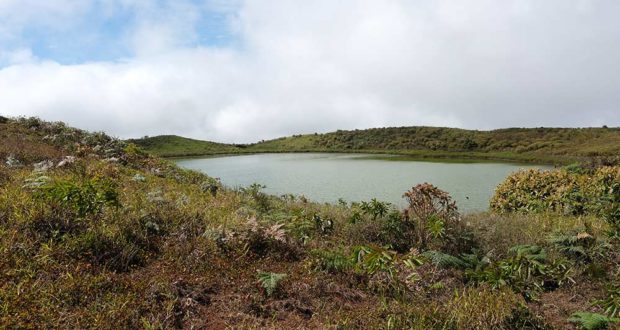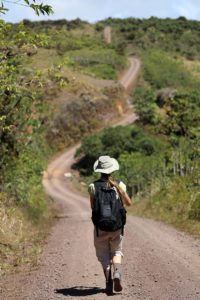…whilst the lower parts of the islands are very sterile, the upper parts, at a height of a thousand feet and upwards, possess a damp climate and a tolerably luxuriant vegetation.
Charles Darwin, 15 September 1835
The contrast between the coast and the highlands in the Galapagos is striking, and driving up the winding road from Puerto Baquerizo Moreno you fast-forward through the landscape. Within a few minutes, you begin to see tall acacia trees surrounded by grassy meadows and grazing cattle. Farther up, a gray mist envelopes the hills, sometimes for days at at time.
On my first visit to the highlands we climbed a steep hill to El Junco, a small lake nestled in an ancient caldera. It is the most substantial collection of fresh water on the islands. Another shallow pond spread out in the valley below, though it appeared to be more transient. Endemic miconia bushes (Miconia robisoniana) and ferns covered the slopes of the hill, creating an ideal habitat for nesting petrels, although we did not see any in the short time we were there.We went searching for petrel nests again a few days later in a scrubby highland forest. We saw a feral horse, tracks in the mud from feral hogs and a couple of finch nests, but no petrels. The trees were draped everywhere with a dark brown moss, which is the primary source of water for the forest. As one of the researchers explained, the mountain mist condenses on the moss and then drips into the ground below.
The cool, dry season in the Galapagos stretches from June through November. It transitions to a warm, wet season beginning in January, when the Palo Santo allegedly have leaves. During my three weeks on the island – at the beginning of the dry season – it rained on the coast only briefly, once, overnight.
The Galapagos nature guidebooks tally seven climate zones on the islands: the coast, the arid zone, a transition to the wetter highlands and then four distinct moist zones in the hills. I could only distinguish three: the dry coast, the lusher highlands and what lies in between.

